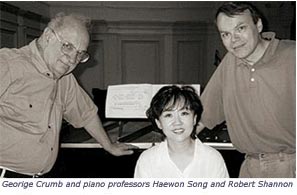
|
|||||||||
 |
Page
1 | Page 2 "If I may say so," Becky Starobin suggests, "I think that our ambition with Bridge shows some of the same missionary zeal that led to the founding of Oberlin College. We're going out there to convert people to this music. In fact, it's more than just a missionary spirit. It's a belief that dedication and caring can make the world a better place. To old hippies like David and me, that goes to the heart of what we do, and it also goes to the heart of what we think about Oberlin. That all these Oberlin people have gotten mixed up in our own operation seems perfectly natural. Believe me, we've worked with musicians from all the conservatories over the years, and Oberlin has a different feeling from any of the others." In fact, Becky once aspired to be an Obie herself, and applied as a violinist when she was still a high-school sophomore in Texas. Although she ended up enrolling at Peabody, she has always carried a special appreciation for Oberlin. "My dad was disappointed that I didn't go to Oberlin," she recalls. "He was a Congregationalist minister, and when we visited the campus together and he saw all those churches lining the square, he really liked that!" Some consolation came when one of Becky's musical sisters, Kathy Askew '76, went to Oberlin as a violist; Becky's other string-playing sisters ended up at Peabody and Curtis. So began a relationship that continues to flourish. Fulkerson's Bridge recordings include chamber works by Gunther Schuller and the late Robert Black '72, a concerto by Richard Wernick, and - Bridge not being just a contemporary-music label - a much-acclaimed reading of Bach's Unaccompanied Sonatas and Partitas. More concertos are on the way. Fulkerson spent his Christmas holidays of 2002 in Prague with David Starobin, committing the Tchaikovsky and Dvorák violin concertos to disc. He records Stephen Jaffe's Violin Concerto in Denmark in May 2003 and is making plans for another Bridge release of standard violin concertos - perhaps Sibelius and Schumann - next season. "I have recorded for other labels," says Fulkerson, "but, frankly, most of my best work has been with Bridge. It has to do with their commitment to the product. Of course they need to stay afloat in the business, but quality stands very high on their mission statement. They don't schedule longer sessions than other producers, but they end up taking more care in all aspects of the production process. Every decision is artistic. And that's how it should be. A studio recording is presumably a statement of some sort. It's supposed to reflect your strongest convictions and best efforts regarding a piece, and we take that aspect very seriously." Shannon similarly finds the Starobins to be kindred souls. Following his collaboration on the Ives violin sonatas, he went on to enrich their catalog with Ives' Concord Sonata, a piano sonata by John Harbison, and a disc of pieces by Tod Machover. "I guess I'm a Bridge artist out of satisfied inertia," he observes. "It's the right sized company and the Starobins are interested in the sorts of projects I would do. Their musical sensibilities are close to mine, perhaps because we are of the same generation. And of course it's a high-quality catalog, in no way a 'vanity press.'" Shannon's first exposure to Crumb was Oberlin's Lorca cycle in 1972. "It made a stunning impression," he recalls, "and I started to dig into his music myself. I went off to graduate school at Juilliard, and in the 1974-75 season I was the first Juilliard pianist to play Crumb's Makrokosmos cycle." But Juilliard had not yet adopted Crumb to the extent that Oberlin had. "At that time," says Shannon, "Oberlin was more involved in new music than any other school. My teacher at Juilliard, Ania Dorfmann, did encourage me to play new music, and that in itself was unusual. So I played Makrokosmos I for her. That was the only book of the Makrokosmos that existed then; it's the one that includes a quotation from Chopin's Fantasie-Impromptu. So I got to the end, and there was a long pause, and then she offered her assessment of my performance of Crumb's Makrokosmos: 'Dear, you don't know how to play Chopin!'" Fulkerson and Shannon seemed a natural choice for Bridge's recording of Crumb's Four Nocturnes for Violin and Piano. Things went swimmingly for Fulkerson, but he allows that the session was not without its challenges. "When the Nocturnes came up on the session schedule, it was the third consecutive day of work for Bob, who had been recording Crumb's Gnomic Variations. By that time, his hands were actually bloody from all the strumming and plucking he'd been doing. In the Nocturnes the pianist has to rap his knuckles on the keyboard, and by that time Bob had already gone through all the convenient knuckles. Didn't he tell you that?" (He had not when I spoke with him a few days earlier. It must have seemed all in a day's work for a Crumb pianist.) Shannon is well represented in the early volumes of the Complete Crumb Edition, both as the soloist in Processional and Makrokosmos I and II and as a duo-partner in Makrokosmos III (aka Celestial Mechanics). In the last he is joined by his wife, Haewon Song, who also teaches piano on the Oberlin faculty. "Celestial Mechanics doesn't get played much," he says, "and I'm sure it's because it simply takes so much rehearsal time. I guess it's best if you're married, or at least in love - and we are both." Among Crumb's most frequently performed pieces is Black Angels (Thirteen Images from the Dark Land), a frightening essay for electric string quartet composed, as the score notes, "in tempore belli, 1970" - that is, in the dark days of the Vietnam War. Many quartets play it strikingly, but for the Complete Crumb Edition the Starobins settled on the Miró String Quartet, which was born in Oberlin in 1995. (Half of its members are Oberlin graduates: violinist Daniel Ching '95 and cellist Joshua Gindele '97.) Now the quartet-in-residence at Kent State University, the foursome was instrumental in putting together a five-day Crumb festival there in September 2002 - Kent being a particularly redolent site given the Vietnam connection of Black Angels. "That festival was actually the first time we played for Crumb," says Gindele, "and we found that he was open to discussing all sorts of ideas about refinements of sound. It turns out that what's notated in the score is no longer what he wants. His thoughts have changed a lot since he wrote the piece, and he intimated that he'd like to bring out a new edition. We presented him with as many options as we could, and we were surprised by how flexible he was. He's a performer himself, and that makes a big difference. Composers who perform even just a little are more effective composers." As with many Crumb works, simply programming Black Angels entails more than usual commitment from performers. "When we book it we have to charge the presenter more," says Gindele, "because we have to travel with so much extra equipment. You need four high-quality microphones and stands, speakers with decent wattage, a processor for reverberations, tuned glasses, gongs, maracas. You can try to rent this stuff locally but usually it's easier to bring your own. That way at least you know you have what you need for a worthy performance. Recently I drove all the way from Ohio to Billings, Montana, just to get all the equipment there." That's commitment. And how did Black Angels play in Billings? "It went over great," he says. "That piece always gets to people, everywhere." [The Miró String Quartet returned to Oberlin this past January, performing Black Angels and other works for an enthusiastic, standing-room-only audience in Kulas Recital Hall. - Ed.] Crumb, in return, evinces an unusual degree of warmth toward his interpreters, and attributes his fascination for producing fanciful manuscripts - their circular and spiraling staves so beautiful that they have been exhibited as artworks - as a way to communicate private delights to performers through a medium that need not concern the audience. For Crumb, participating in the recordings provides an important opportunity. "I've been at all the sessions," he says. "I felt like once the project got started it made sense for me to be in on them. It becomes almost a supplement to the score, you know - a way to see that your own feelings about the piece get into the recording, to get things as I hear it in my inner ear. Yup. And, gosh, they all play so well." That a new generation of Oberlin musicians has embraced Crumb's music with such enthusiasm brings immense joy to those who have now championed him for decades. Says Fulkerson, "The atmosphere here at Oberlin is conducive to making sure students explore the music of their own time. When people do that without an ideological bias, quite a few will find Crumb's music to be powerful and unusual, and they will ultimately be drawn to it. Oberlin can take some credit for producing an environment where this attitude can grow." II James M. Keller '75, BA '75 is Program Annotator of the New York Philharmonic and the San Francisco Symphony. From 1990 to 2000 he wrote about music and recordings on staff at The New Yorker and in 1999 was honored with the ASCAP-Deems Taylor Award for distinguished music journalism. His first encounter with Crumb's music was the Lorca cycle premiere at Oberlin in 1972, and he's been hooked ever since. His writings on Crumb have previously been published by The New Yorker, Chamber Music (which he serves as contributing editor), and Le Monde de la Musique. He lives in Santa Fe, New Mexico. Page 1 | Page 2 |
||

 Two
professors on the Oberlin faculty, violinist Gregory Fulkerson '71
and pianist Robert Shannon '71, boast numerous entries in the Bridge
catalog. Fulkerson knew the Starobins in the 1970s, and not long
after they founded their label, he sent them "on spec" a sample
recording he had made of the Ives violin sonatas. They liked what
they heard, and in 1989 produced a disc of those pieces performed
by Fulkerson and Shannon.
Two
professors on the Oberlin faculty, violinist Gregory Fulkerson '71
and pianist Robert Shannon '71, boast numerous entries in the Bridge
catalog. Fulkerson knew the Starobins in the 1970s, and not long
after they founded their label, he sent them "on spec" a sample
recording he had made of the Ives violin sonatas. They liked what
they heard, and in 1989 produced a disc of those pieces performed
by Fulkerson and Shannon.